Understanding Qualcomm's Snapdragon 810: Performance Preview
by Joshua Ho & Andrei Frumusanu on February 12, 2015 9:00 AM EST- Posted in
- SoCs
- Qualcomm
- Mobile
- Gobi
- Snapdragon 810
CPU/System Performance
While talking about the energy aware scheduler and various other aspects of the Snapdragon 810 is helpful to understand how the SoC works, ultimately we must look at performance to determine whether Qualcomm's work to differentiate their SoC was worthwhile or not. To do this, we ran Qualcomm's tablet Mobile Development Platform (MDP) through our standard suite of benchmarks, although I was unable to run benchmarks such as BaseMark X and PCMark due to odd issues with the tablet.
Starting off, we have a complete breakdown of GeekBench 3 scores. The scores are closer to theoretical performance than real-world performance, but it's very useful for highlighting architectural changes. For our look at GeekBench we are comparing the 810 reference platform to our results from our recent Galaxy Note 4 Exynos review, along with results for the Snapdragon 805-based Galaxy Note 4 taken from the GeekBench database.
| GeekBench 3 - Integer Performance | |||||||
| Snapdragon 805 (ARMv7) | Exynos 5433 (AArch32) | Snapdragon 810 (AArch64) | S810 > S805 % Advantage | ||||
| AES ST | 85.4 MB/s | 1330 MB/s | 604.9 MB/s | 608% | |||
| AES MT | 350.4 MB/s | 4260 MB/s | 3050MB/s | 770% | |||
| Twofish ST | 94.0 MB/s | 81.9 MB/s | 85.7 MB/s | -8.8% | |||
| Twofish MT | 329.8 MB/s | 440.5 MB/s | 448.5 MB/s | 36% | |||
| SHA1 ST | 202.1 MB/s | 464.2 MB/s | 428.1 MB/s | 112% | |||
| SHA1 MT | 806.1 MB/s | 2020 MB/s | 3019 MB/s | 275% | |||
| SHA2 ST | 95.1 MB/s | 121.9 MB/s | 81 MB/s | -15% | |||
| SHA2 MT | 367.3 MB/s | 528.3 MB/s | 393.4 MB/s | 7.1% | |||
| BZip2Comp ST | 4.46 MB/s | 4.88 MB/s | 4.99 MB/s | 12% | |||
| BZip2Comp MT | 15.5 MB/s | 19.3 MB/s | 20.5 MB/s | 32% | |||
| Bzip2Decomp ST | 6.43 MB/s | 7.41 MB/s | 7.99 MB/s | 24% | |||
| Bzip2Decomp MT | 21.7 MB/s | 29.7 MB/s | 30.8 MB/s | 42% | |||
| JPG Comp ST | 20.4 MPs | 19.3 MPs | 18.9 MP/s | -7.4% | |||
| JPG Comp MT | 79.9 MP/s | 88.8 MP/s | 88.9 MP/s | 11% | |||
| JPG Decomp ST | 30.6 MP/s | 43.5 MP/s | 36.3 MP/s | 19% | |||
| JPG Decomp MT | 115.7 MP/s | 149.6 MP/s | 182.7 MP/s | 58% | |||
| PNG Comp ST | 0.82 MP/s | 1.11 MP/s | 1.11 MP/s | 35% | |||
| PNG Comp MT | 3.01 MP/s | 4.57 MP/s | 4.78 MP/s | 59% | |||
| PNG Decomp ST | 18.7 MP/s | 19.1 MP/s | 15.6 MP/s | -17% | |||
| PNG Decomp MT | 63.7 MP/s | 78.8 MP/s | 94.1 MP/s | 48% | |||
| Sobel ST | 39.2 MP/s | 58.6 MP/s | 53.3 MP/s | 36% | |||
| Sobel MT | 128 MP/s | 221.3 MP/s | 248.4 MP/s | 94% | |||
| Lua ST | 0.92 MB/s | 1.24 MB/s | 1.30 MB/s | 41% | |||
| Lua MT | 1.36 MB/s | 2.48 MB/s | 5.93 MB/s | 336% | |||
| Dijkstra ST | 4.46 Mpairs/s | 5.23 Mpairs/s | 3.38 Mpairs/s | -24% | |||
| Dijkstra MT | 13.2 Mpairs/s | 17.1 Mpairs/s | 13.7 Mpairs/s | 3.8% | |||
Thanks in large part to the new cryptographical capabilities of the ARMv8 cores, Snapdragon 810 gets off to a very good start in GeekBench 3's integer benchmarks. Once we move on to the rest of our benchmarks, we find that 810 continues to hold a considerable advantage through most of these benchmarks; BZip2 decompression, Lua script performance, and JPEG decompression all show considerable performance gains over the Snapdragon 805 based Galaxy Note 4. Snapdragon 810's overall performance improvement here is a rather large 45%, though if we throw out the especially large gains that come from Lua MT, the overall performance advantage is closer to 30%.
There are a few cases where performance regresses however, including in PNG decompression and Dijkstra's algorithm. This could be a result of memory performance (more on that later) or architectural differences. It's worth pointing out that these cases are also among the only cases where Snapdragon 810 notably trails the Exynos 5433.
| GeekBench 3 - Floating Point Performance | |||||||
| Snapdragon 805 (ARMv7) | Exynos 5433 (AArch32) | Snapdragon 810 (AArch64) | S810 > S805 % Advantage |
||||
| BlackScholes ST | 4.33 Mnodes/s | 4.37 Mnodes/s | 5.01 Mnodes/s | 16% | |||
| BlackScholes MT | 17.0 Mnodes/s | 20.4 Mnodes/s | 25.5 Mnodes/s | 50% | |||
| Mandelbrot ST | 0.87 GFLOPS | 1.14 GFLOPS | 1.20 GFLOPS | 38% | |||
| Mandelbrot MT | 3.45 GFLOPS | 5.09 GFLOPS | 6.41 GFLOPS | 86% | |||
| Sharpen Filter ST | 886 MFLOPS | 1030 MFLOPS | 1007 MFLOPS | 14% | |||
| Sharpen Filter MT | 3.54 GFLOPS | 4.31 GFLOPS | 5.02 GFLOPS | 42% | |||
| Blur ST | 1.18 GFLOPS | 1.27 GFLOPS | 1.26 GFLOPS | 6.8% | |||
| Blur MT | 4.67 GFLOPS | 5.03 GFLOPS | 6.14 GFLOPS | 31% | |||
| SGEMM ST | 2.82 GFLOPS | 1.81 GFLOPS | 2.29 GFLOPS | -19% | |||
| SGEMM MT | 8.05 GFLOPS | 6.1 GFLOPS | 6.12 GFLOPS | -24% | |||
| DGEMM ST | 0.81 GFLOPS | 0.57 GFLOPS | 1.03 GFLOPS | 27% | |||
| DGEMM MT | 2.69 GFLOPS | 2.29 GFLOPS | 2.81 GFLOPS | 4.5% | |||
| SFFT ST | 1.16 GFLOPS | 1.1 GFLOPS | 1.25 GFLOPS | 7.8% | |||
| SFFT MT | 4.55 GFLOPS | 4.56 GFLOPS | 4.11 GFLOPS | -9.7% | |||
| DFFT ST | 0.47 GFLOPS | 1.02 GFLOPS | 1.03 GFLOPS | 119% | |||
| DFFT MT | 1.89 GFLOPS | 3.46 GFLOPS | 2.97 GFLOPS | 57% | |||
| N-Bod ST | 331.5 Kpairs/s | 370.4 Kpairs/s | 486.6 Kpairs/s | 47% | |||
| N-Bod MT | 1.12 Mpairs/s | 1.44 Mpairs/s | 1.72 Mpairs/s | 54% | |||
| Ray Trace ST | 1.48 MP/s | 1.7 MP/s | 1.73 MP/s | 17% | |||
| Ray Trace MT | 5.77 MP/s | 6.65 MP/s | 8.16 MP/s | 41% | |||
GeekBench's floating point performance shows a similar range of performance increases. More often than not multi-threaded performance gains exceed single-threaded performance gains, which is a hopeful sign for how well the Snapdragon 810 reference platform can hold up when all four big cores are being hammered. Otherwise the 810 shows considerable performance gains on almost every benchmark here, the sole exception being SGEMM performance.
In this case Snapdragon 810 performance is relatively close to Exynos 5433 performance even though it has the advantage of running in AArch64 mode, which should give the FP numbers a boost over the Exynos. The SGEMM test is likely an isolated case where the Krait architecture and Snapdragon 805's high clock speed play to its favor. The overall Snapdragon 810 performance improvement is 30%, almost exactly what we saw with GeekBench integer performance as well (after throwing out Lua MT).
| GeekBench 3 - Memory Performance | ||||||
| Snapdragon 805 (ARMv7) | Exynos 5433 (AArch32) | Snapdragon 810 (AArch64) | S810 > S805 % Advantage |
|||
| Stream Copy ST | 8.37 GB/s | 5.56 GB/s | 6.02 GB/s | -28% | ||
| Stream Copy MT | 10.2 GB/s | 5.80 GB/s | 7.57 GB/s | -26% | ||
| Stream Scale ST | 5.17 GB/s | 4.98 GB/s | 6.61 GB/s | 28% | ||
| Stream Scale MT | 8.05 GB/s | 5.77 GB/s | 7.37 GB/s | -8.4% | ||
| Stream Add ST | 5.06 GB/s | 4.85 GB/s | 5.64 GB/s | 11% | ||
| Stream Add MT | 7.46 GB/s | 5.72 GB/s | 6.62 GB/s | -11% | ||
| Stream Triad ST | 5.37 GB/s | 4.82 GB/s | 5.6 GB/s | 4.3% | ||
| Stream Triad MT | 8.20 GB/s | 5.73 GB/s | 6.63 GB/s | -19% | ||
Usually we don't like to post the GeekBench memory scores, but in this case there is an interesting phenomenon going on with the Snapdragon 810. Although the LPDDR4 memory running at 1555MHz gives the SoC a large advantage in memory bandwidth over the Exynos 5433 and runs its CCI at 787 MHz, giving the CPU port a theoretical 12.6 GB/s that's much more than the 6.6GB/s of the 5433, the actual measured bandwidth difference is much less and is nowhere near that figure in any of the sub-tests.
To look at this in more detail, we use AndEBench's memory benchmarks, and indeed we see a similar result.
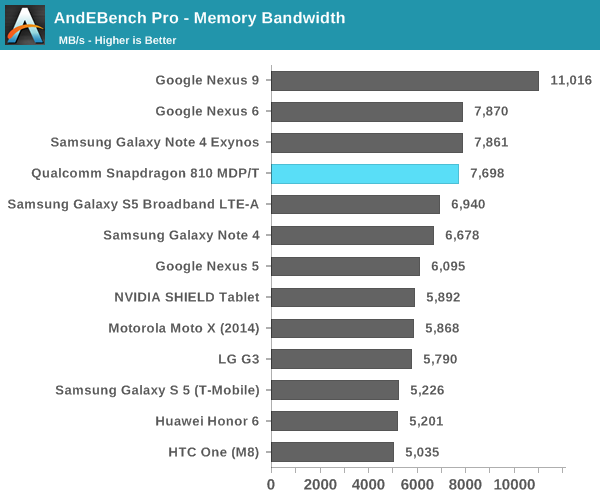
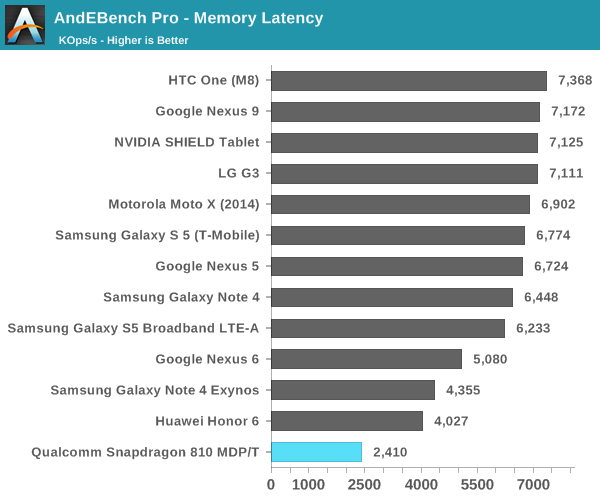
It's the memory latency test in particular that's very worrisome, as the MDP tablet achieves a very bad throughput score. We're not sure why this happens, but we hope to investigate this further in the future when we get the chance to review a shipping Snapdragon 810 device.
Continuing on, let's look at our browser bench suite.
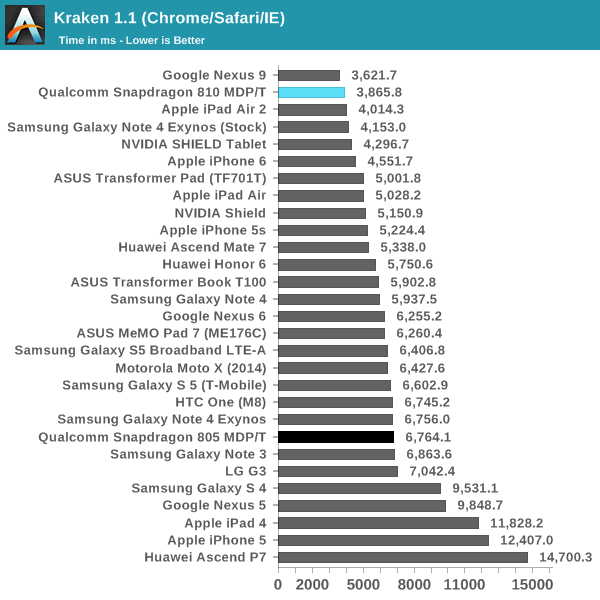
Here, the Snapdragon 810 is off to quite a start. While not a direct correlation, performance in these benchmarks can generally be correlated with CPU performance. The Snapdragon 810 shines here and approaches the Nexus 9, which has a strong showing due to the underlying Denver CPU's code optimizer unrolling loops in the benchmark.
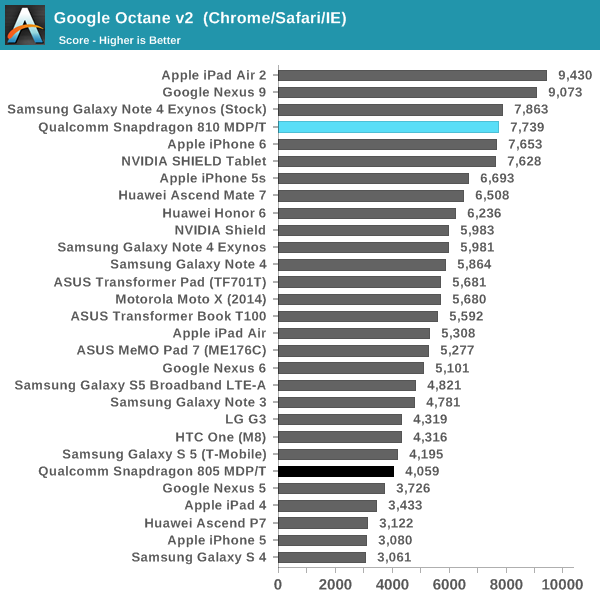
In Octane, we see that the Snapdragon 810 continues to be competitive with some of the fastest SoCs available today.
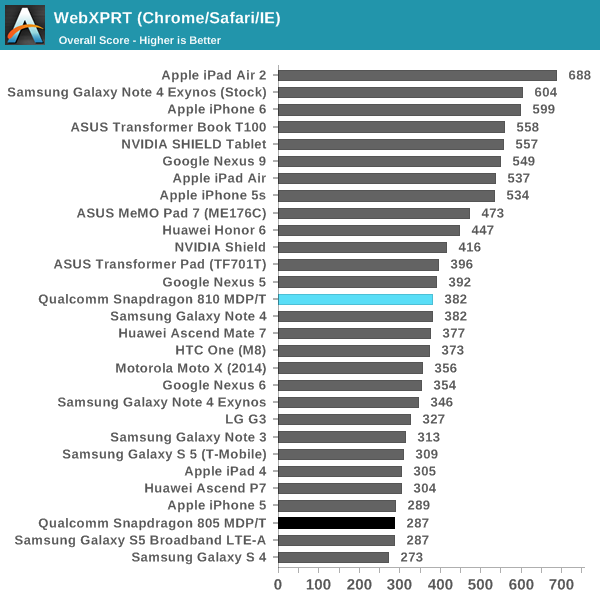
On the other hand, in WebXPRT we see that performance ends up somewhere around the level of the Snapdragon 801. It's possible that we're looking at thermal throttling or some other issue here as I was unable to run multiple trials of this test. Our browser based tests are otherwise generally consistent with what we found earlier this week on the A57-based Exynos 5433, so it's unlikely we're looking at an unoptimized Chrome build.
Continuing with the benchmarks we were able to perform at the performance preview, BaseMark OS II is next.
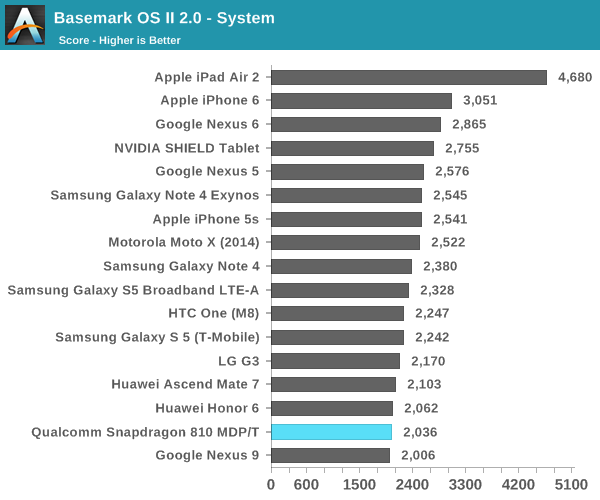
The System numbers of the Snapdragon 810 MDP/T seem disappointing, as it falls at the lower end of our current flagship device lineup. It seems the reference platform isn't as well optimized as it should be.
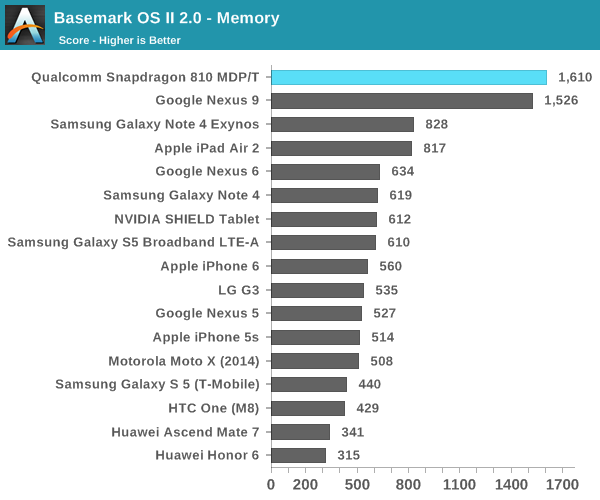
Similar to the Nexus 9, we see some odd trends in the memory tests. It isn't quite clear what's causing this, but a performant eMMC is certainly a possibility. Due to this test being very device specific, we can't really judge the Snapdragon 810's performance here.
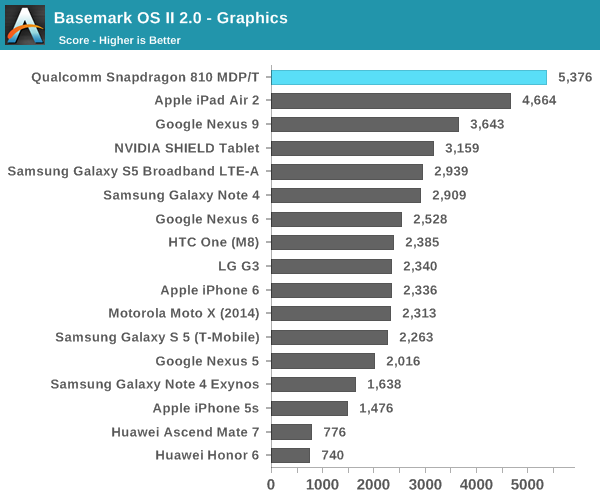
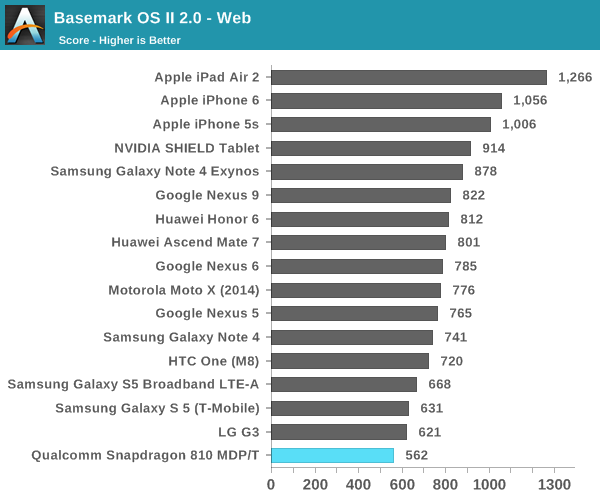
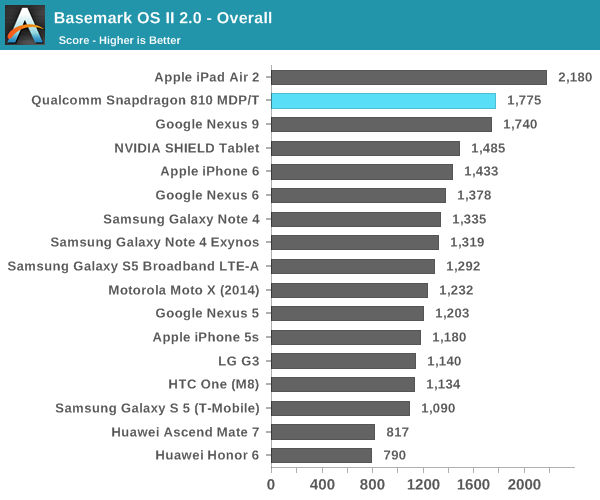
As for BaseMark, what we get are very binary results with the 810 either coming in near the top or bottom. The overall score still looks quite good as a result, boosted by things such as chart-topping graphics performance. On the other hand the web and system scores are struggling, coming in 20% or more behind the Note 4 and it's A57 based Exynos 5433. Since this is an early device this may be a case of early teething issues with performance, possibly with optimizations or the OS, but at this point in time it's difficult to confirm anything.
Meanwhile looking at how Qualcomm's reference platform compares to the Snapdragon 805-based Nexus 6, we find some significant performance gains at times. Though Krait has held up admirably against its A15 based competition, A57 finally provides a solid jump in performance over what even the fastest Krait can offer.










119 Comments
View All Comments
warreo - Wednesday, February 18, 2015 - link
HAHAHA Tchamber you are a jewel. Thanks for making my morning. Here I was wondering if a week later anybody else had anything intelligent to say....Your analogy of the 5433 as a Lamborghini and the Snapdragons as Corvette/Camaro/GT500 is horrible. Period. Anybody who reads this site should know that. If you really want to get into an argument with someone, you should actually know what you're talking about before insulting them.
As for me, I wasn't talking to down to anyone. I gave AT my observations and also did in fact summarize my own conclusions if you'd bothered to read my comments in totality. Just because I disagree with them doesn't mean I'm talking down to them. You, however, should run along back to pre-school and learn how not to be a prick to others.
djvita - Thursday, February 12, 2015 - link
found some typoslast paragraph GPU performance "Qualcomm has narrowedmuch"
CPU performance
PNG Comp ST 0.82 MP/s 1110 MP/s 1.11 MP/s 35%
is 1110 correct? found the difference to be very high....
All in all, preliminar benchamrks looks good. Seems anandtech will need a flex2/mi note pro or the upcoming htc m9 in MWC (for sony no rumors, until july i think, lg g4 maybe in may. S6 wont be qualcomm)
Ratman6161 - Thursday, February 12, 2015 - link
Another typo:There are three tables at the top of the CPU Performance page. The last column in the first table says: Snapdragon % Advantage which clearly isn't correct because just in the first line the Samsung has about a 2 to one advantage it says the snapdragon advantage is 608%. I assume you actually meant this column to say but S810 > S805 % Advantage like in the second two tables.
djvita - Thursday, February 12, 2015 - link
they fixed them all now, it was 1.11SydneyBlue120d - Thursday, February 12, 2015 - link
Very interesting article. Do you think it is possibile the Galaxy S6 devices will use the MDM9x45 modem?deathBOB - Thursday, February 12, 2015 - link
Subjective impressions? Andrei pointed out that the Exynos was subjectively faster than the 805. How does the 810 fare?MrCommunistGen - Thursday, February 12, 2015 - link
Thanks for the informative article! The scope of the article as a whole goes far beyond a Preview of Snapdragon 810, specifically the sections on RF and Qualcomm's scheduler.That in mind, I'll hold off on passing judgement on S810's performance until we see shipping silicon. Between pre-release drivers and differences in chassis/thermals "Performance Preview" *is* spot on for the whole benchmarks section.
Even though S810 is Qualcomm's stopgap and there's only so much you can do (for better or worse) to the performance of off the shelf A57/A53 cores, I'm glad they're still in the game - or at least not out of it. Even as a preview, it is clear that Adreno 430's performance is more than just an iterative increase over Adreno 420.
Regardless of how S810 shakes out, I'm sure Qualcomm is baking all of their learnings from working on this SoC into their in-house ARMv8-A design
Mr.r9 - Thursday, February 12, 2015 - link
Even though this is a preview and drivers/Kernel will definitely improve....I still feel that the 810 will underwhelm.djvita - Thursday, February 12, 2015 - link
considering I still have an msm8960 device, this will be a huge jump for me.tviceman - Thursday, February 12, 2015 - link
This performance preview just reaffirms two of my beliefs.1) It's a shame that Nvidia couldn't get more products with Tegra K1 in it, seeing how K1 has been on the market for many months and generally outperforms the 805 (sometimes by a wide margin)
2) It's a shame that Tegra X1 will likely suffer the same limited release fate that Tegra K1 suffered, even if manufacturers were to downclock Tegra X1 to meet smaller TDP demands. X1, even if downclocked, will run circles around 805.